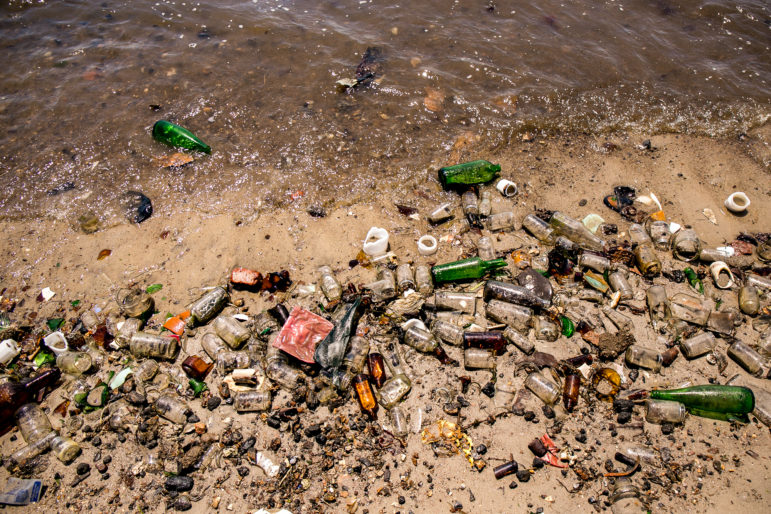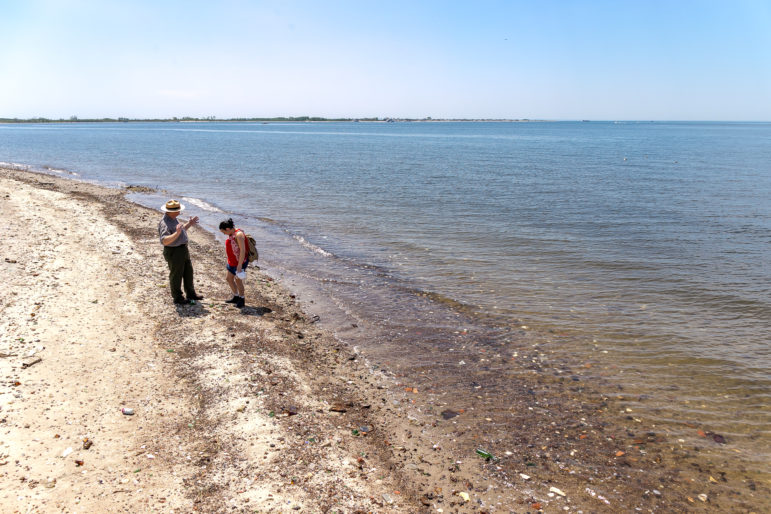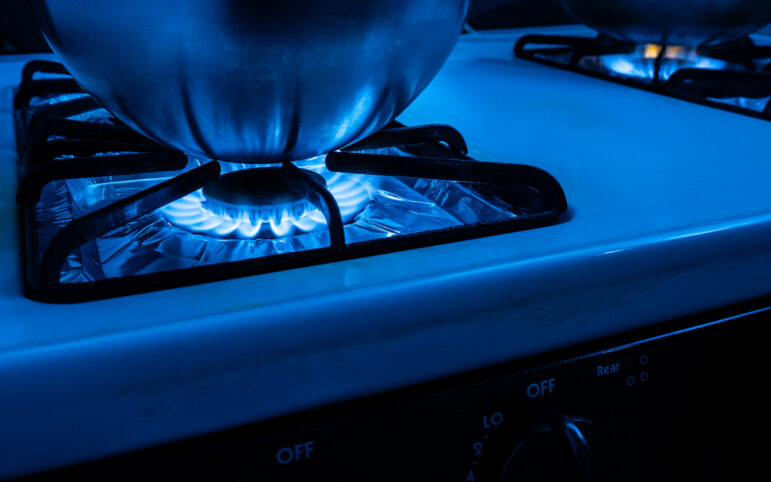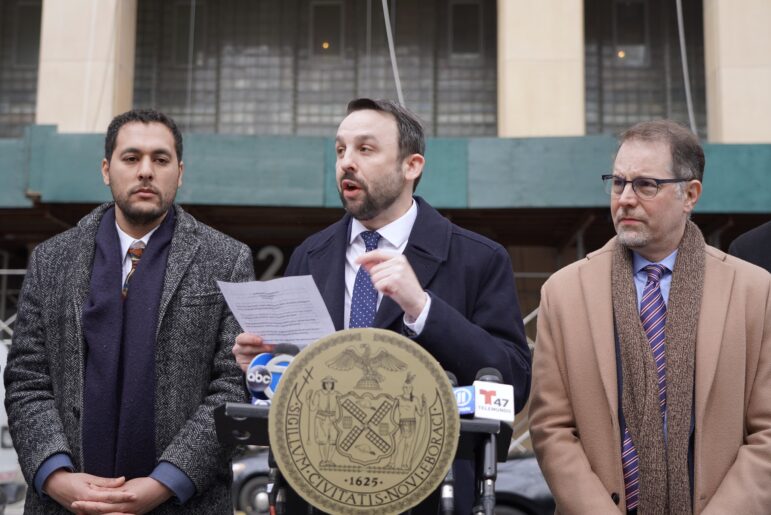
Adi Talwar
Hard to reach and lacking amenities, Gateway National Recreation Area's 'Bottle Beach' bears daily witness to the deterioration of an old city landfill.
When most New Yorkers hear about cuts to the National Parks Service, they think about Yellowstone or the Grand Canyon, not the wetlands around Cross Bay Boulevard on the way to the Rockaways or the beach on top of a landfill behind the tollbooths on the Marine Park Bridge.
But that’s New York City’s national park, a 27,000-acre smattering of shoreline and marshland called the Gateway National Recreation Area. Park advocates and local officials say Gateway — which includes lands in Queens, Brooklyn, Staten Island and New Jersey — is an underutilized and underfunded park in an area starved for more open space. That was set to change, but looks less likely under a Trump administration that’s proposed massive cuts to the National Parks Service and Environmental Protection Agency.
“The public is desperate for open space and recreational opportunities of any kind in a crowded city and yet the Trump administration is looking to slash the budget of the National Parks Service,” says Judith Enck, former director of the EPA’s Region 2 who created a working group last summer to figure out how to clean up one of the park’s most challenging sites: Dead Horse Bay.
“New York state has virtually no national parks,” adds Enck. “What better investment is there for New Yorkers?”
Only recently, Gateway’s future looked bright. Following two decades of reports with hundreds of ideas on what to do to fix up the area, especially the Jamaica Bay section in Brooklyn and Queens, agencies had finally started to coordinate and the U.S. Army Corps of Engineers in developing a plan for restoring the area to its natural roots and cleaning up its polluted and neglected past.
Visitor numbers at the park rebounded last year to levels not seen since Hurricane Sandy as more New Yorkers were kayaking, biking, fishing and swimming at Gateway. The park had 8.6 million visitors in 2016, more than Yellowstone or Grand Canyon. But that’s likely because the park sits on the edge of the most populous city in the country. Even the National Parks Service admits the park is mostly unknown.
“Gateway is one of the ten most visited parks in the nation, but there are still many who have no idea Gateway is in New York City’s backyard,” says Daphne Yun of the National Parks Service.
That may not change any time soon. There’s no shortage of ideas, but significant improvements would require a large influx of federal funding. Advocates are worried that due to budget cuts, it may be hard to simply maintain the status quo.
For fiscal year 2018, the Trump administration is pushing for an $1.5 billion* cut to the Department of the Interior, which operates the National Parks Service, and a $2.4 billion cut to the Environmental Protection Agency.
While it’s unclear right now exactly what a hacked budget will mean for Gateway — it likely means the park’s already stagnant funding and diminished levels of staffing aren’t going to get any better. The park already has a $730 million maintenance backlog and U.S Army Corps of Engineers’ plan requires a lot of federal funding that may be hard to come by under a Trump administration and Republican-controlled Congress.
Dead horses and rusty roller-skate wheels
Gateway is an unusual national park. The park includes three sections: Sandy Hook in New Jersey; Great Kills Park, Miller Field and Fort Wadsworth on Staten Island; the Jamaica Bay Wildlife Refuge, Fort Tilden and Riis Park in Queens; Floyd Bennett Field and Canarsie Pier in Brooklyn.
In some ways, Gateway is a park that’s more a part of New York City than an escape from it. The park’s perpetually under construction visitor center is in a line of vacant and dilapidated buildings on Flatbush Avenue near Floyd Bennett Field, New York City’s first municipal airport.
Two of those buildings have been renovated and restored, but only because they’re being leased to a natural gas company. Across the street, the beach locals call “Bottle Beach” is the eroding edge of a landfill. Every tide drags more and more historical trash into adjacent Dead Horse Bay, where a mill used to grind up horse bones during the city’s carriage era.
“Bottle Beach” on Dead Horse Bay is easily one of the weirdest stretches of land with National Park designation in the country. And there’s no spot in Gateway that better illustrates the challenges of improving the park, but also how recent efforts to do that are now jeopardized by looming budget cuts.
It’s not easy to find down a sandy path on the side of Flatbush Avenue, but Bottle Beach is open to the public. Swimming is not a good idea because the beach is covered in broken glass, wrecked boats and whatever trash hasn’t decomposed since the city created the landfill in the 1920s to connect Barren Island to mainland Brooklyn. The National Parks Service simply doesn’t have the funds to clean it up.
They don’t do any maintenance, in fact. The only amenity on the beach is a single bench, but they didn’t even put it there; it washed up on the shore during Hurricane Sandy.
“You know what this is?” asked National Park Ranger Lincoln Hallowell on a recent trip to Bottle Beach. He held up a chunk of metal deformed by rust. “This is the wheel of a roller skate.”
Later on, pointing to a strip of rubber protruding from the side of a sand dune, Hallowell says, “That looks like it might be a tire off of a Model T or something.”
A complex cleanup

Adi Talwar
A clean-up of the site would be complex, partly because NPS property can't be part of the Superfund and also because the city's landfill is assumed to be the chief source of pollution.
Nobody knows for sure what is in the landfill that’s slowly eroding into Dead Horse Bay. That hasn’t stopped fishermen from catching blues and bass. Local artists and historians love it, too, because it offers a glimpse into life in Brooklyn 100 years ago.
Enck, who served for seven years as director of the EPA’s Region 2 until earlier this year, says the continuing deterioration of the landfill is a problem that government agencies cannot ignore any longer. “Every day it gets worse,” she says. “This is a serious issue.”
Last summer, she organized a Dead Horse Bay Working Group to bring agencies together to find a way to fund the cleanup. “I organized a field trip for every single state and city regulator I could find,” says Enck. “And everyone was just stunned.”
Enck says the site has “Superfund” potential, but first the EPA would have to figure out what hazardous material is there. Technically, federally-owned parkland can’t be designated a Superfund site, but the same law that created superfund (Comprehensive Environmental, Response, Compensation and Liability Act or CERCLA) can require the National Parks Service to clea nup toxic sites. Gateway already has a site like that, in fact. High levels of radioactivity were found at Great Kills Park in 2005 and the National Parks Service has started working to clean up the site and is currently doing “a comprehensive remedial investigation and feasibility study,” that is scheduled to be completed in 2020.
Dead Horse Bay presents a complex problem because the National Parks Service inherited the mess from the City of New York; that means it’s unclear who would end up paying for the cleanup. Right now at least, the National Parks Service is responsible for cleaning its own site and says it will continue working with the EPA for a possible remediation.
“It’s a challenging site, but it offers a lot of benefits for the community,” says Rob Pirani, director of the New York-New Jersey Harbor & Estuary Program. “It poses a lot of challenges, the least of which is what to do with the historical material.”
Lauren Cosgrove from the National Parks Conservation Association said ideally any cleanup of the site would somehow incorporate historical items from the landfill into the park. Household items from a century ago are every day being unearthed by the tide.
“You could leave some of the bottles and artifacts there, maybe not physically on the ground, but in a display,” she said. “There’s such a rich history there.”
“It should be a public resource, but there’s a legacy of pollution and some agency has to own this and find the money to clean this up,” says Enck. “The status quo is unacceptable.”
A lot of chefs
There have been projects in the Jamaica Bay area to restore wetlands and create berms to prevent flooding, but one problem is that these smaller projects from a variety of agencies at every level of government are done independently of one another.
The recent Army Corps of Engineers (USACE) feasibility study says without a clear, multi-agency effort, the future will see “disjointed projects, missed opportunities and overall inefficiencies in restoring the Jamaica Bay Planning Region.”
That is still the fear, especially if federal funding doesn’t come through. The USACE recently issued a draft feasibility report for a 25-mile radius around the Statue of Liberty. Jamaica Bay is one of six areas the report highlights as in need of ecosystem restoration.
Funding that plan is perhaps the biggest question mark for the future success of Gateway. All of the agencies needed to make it happen seem to be on board, all that’s needed is a commitment of federal funding to do make it become a reality.
USACE estimates it will cost $289 million to restore disappearing wetlands and marshes in Jamaica Bay, including removing the landfill at Dead Horse Bay. The city’s Department of Environmental Protection and state’s Department of Environmental Conservation sponsored the report and are on board for funding. But the bulk of the funding, $190 million, would need to come from the feds.
“That’s what’s really challenging. Everything costs so much,” says Lisa Baron, project manager, for the USACE’s New York district. “To fight nationally for this region is so challenging because you can restore other areas a lot cheaper.”
Aside from the ecological benefits of improving the area (which Baron says will help prevent flooding during storms), advocates say an improved national park would offer more opportunity for New Yorkers to escape the city without actually leaving it.
“Gateway is an incredible asset in an increasingly crowded city and in a city where water-based recreation is growing in popularity,” said Pirani.
Cortney Worrall, director of the National Parks Conservation Association’s Northeast office in New York City, says her office is working on the “low-hanging fruit” given budget constraints like improving maps and signage — and pushing the MTA to send more buses to the park in the summer.
“Gateway is a critical urban park and one of the largest natural areas in New York City. It’s one of the most important urban parks in the national parks system because it serves as a backyard to millions of new Yorkers,” she says. “It’s hard for the National Parks Service to make plans for the coming years … and grow in their ability to meet the needs of the community. All that gets put on hold when there’s this potential looming cut.”

Adi Talwar
National Park Ranger Lincoln Hallowell speaking with New Port City gallery owner Melissa Seitz on the shore of Bottle Beach.
* Correction: This figure was initially misstated at $11.6 billion. We regret the error.









3 thoughts on “Next 100 Days: How Park Service Cuts Will Hurt NYC’s Most Neglected Beach”
I’ve lived in The Rockaway my entire life…..Gateways Riis Park area has been neglected since it became a federal park. When the city owned it it was pristine, had manicured lawns. Clean walkways, and a beautiful boardwalk with concessions . Now the once manicured grass is 6-8 ft high weeds that are filled with garbage. The trees are dead. It’s a disgrace ! And no one cares. I’ve called gateway to see why it looks this way and they laugh .
Why? Because your Congressional reps don’t work harder to assure the needed money is in the budget. Since Gateway was created the National Park Service operations money and staffing has been on a downward spiral. As maintenance and mid-level jobs are cut, the National Park Service tries to fix the daily maintenance vacuum with construction contracts, and obviously yard and cleanup work won’t compete for funds with fixing the roof or stairs on a historic building. If park staff really did laugh, it was probably laugh or cry.
Also doesn’t help that Rockaway residents don’t pick up after themselves. The park service doesn’t create the trash, it is from the locals. And don’t even blame the visitors that is a two to three month problem, that place is a mess all winter long.